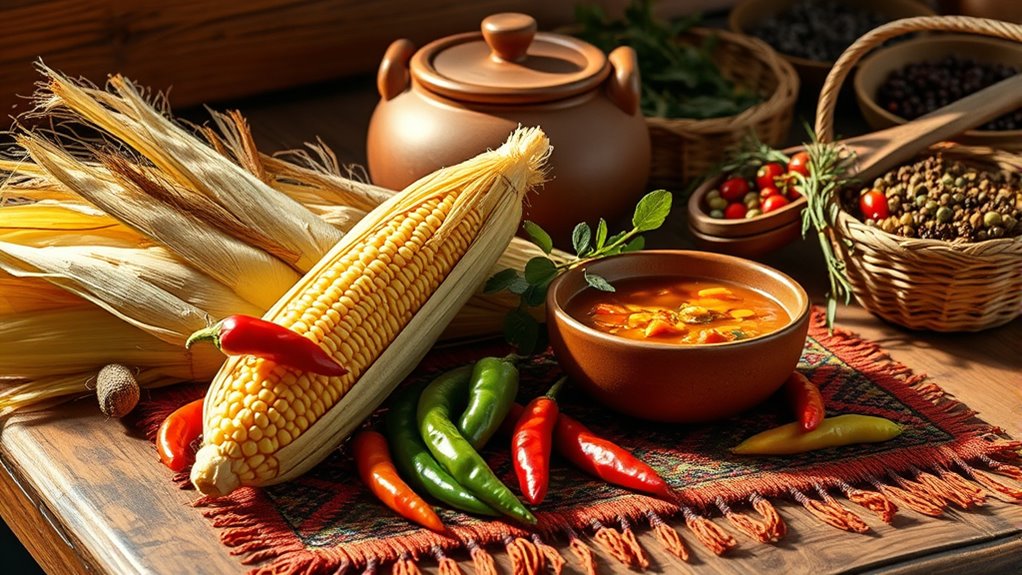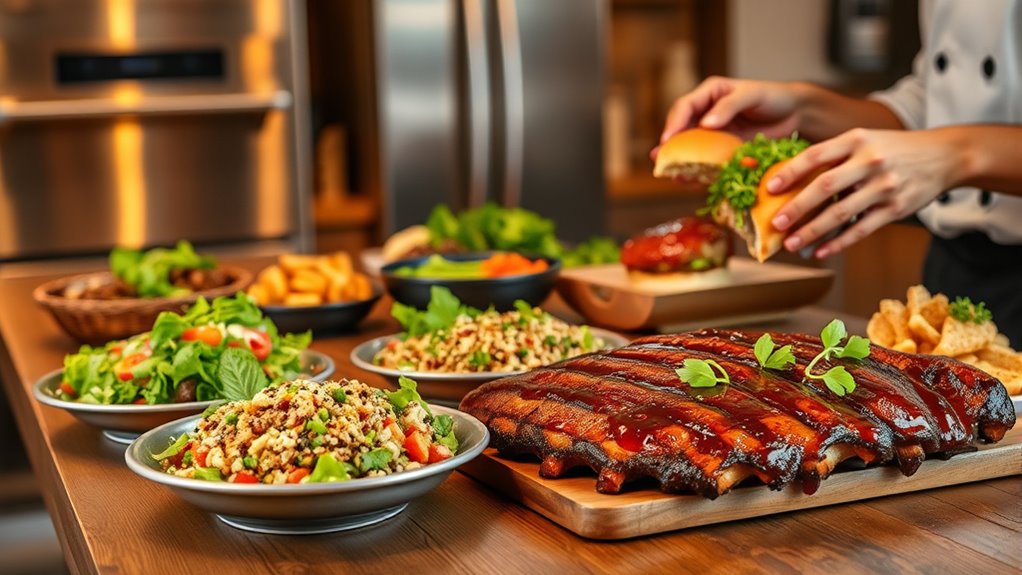American cuisine is a rich blend of Native American roots, immigrant influences, and regional flavors. You’ll find dishes like soul food in the South, clam chowder in the Northeast, and Tex-Mex in the Southwest. Modern trends emphasize local ingredients, diverse global flavors, and sustainable practices, while technology and immigration continually shape new culinary innovations. If you want to explore how these elements come together, keep exploring the vibrant culinary traditions that make up the USA.
Key Takeaways
- Native American ingredients like corn, squash, and wild game laid the foundation for early American cuisine.
- Regional dishes such as gumbo in the South, clam chowder in the Northeast, and barbecue in the Pacific Northwest define local flavors.
- European, African, and immigrant influences have diversified American culinary practices, introducing new ingredients and cooking techniques.
- Modern trends emphasize farm-to-table, plant-based options, and innovative food presentation for social media.
- Technological advancements and immigrant cuisines continue to shape America’s dynamic and multicultural food scene.
Native American Foundations of American Cuisine

Have you ever wondered how Native American traditions laid the groundwork for what we now think of as American cuisine? Native Americans introduced early settlers to essential ingredients like squash, berries, and local game, shaping the foundation of American food culture. They developed techniques for harvesting, cooking, and preserving these foods, passing down recipes and practices that remain influential today. For example, corn became a staple crop, integral to many dishes and cultural rituals. Native Americans also shared methods for smoking and drying meat, which influenced food preservation. Their rich knowledge of wild plants and ingredients provided a diverse palette for early Americans. Additionally, their food preservation techniques contributed significantly to the development of sustainable food practices that are still relevant. Understanding this legacy reveals how Native culinary traditions continue to echo through the flavors and practices of modern American cuisine.
Historical Evolution of American Food Practices

The rich culinary foundation established by Native Americans set the stage for ongoing changes in American food practices over centuries. When European settlers arrived, they brought new ingredients like meat and dairy, blending with indigenous foods and creating early hybrid cuisines. The African slave trade introduced bold flavors and cooking techniques, shaping soul food traditions that persist today. Throughout the 19th and 20th centuries, waves of immigrants added diverse culinary influences, expanding regional flavors and dishes. Technological advances and scientific understanding led to innovations, while urbanization increased food diversity. The late 20th century saw movements like farm-to-table emphasizing local ingredients, and fast food revolutionized eating habits. Additionally, preservation efforts of historic farmhouses and culinary sites have helped maintain the cultural significance of regional food practices heritage preservation. These developments reflect America’s evolving cultural landscape and its continuous adaptation of culinary practices over time.
Iconic Dishes and Culinary Traditions Across Regions

Across the diverse regions of the United States, culinary traditions have developed distinctive dishes that reflect local ingredients, cultural influences, and historical roots. In the South, you’ll find soul food staples like fried chicken, collard greens, and gumbo, influenced by African and Native American flavors. Moving to the Northeast, clam chowder and lobster rolls showcase maritime ingredients. In the Midwest, hearty dishes like deep-dish pizza and bratwurst highlight German and Eastern European roots. The Southwest is famous for Tex-Mex cuisine, blending Mexican spices with American ingredients, while the Pacific Northwest emphasizes fresh salmon and farm-to-table practices. Regional barbecue styles, from Texas brisket to North Carolina pulled pork, showcase local traditions. These dishes embody the country’s regional diversity, history, and cultural melting pot.
Modern Trends and Innovations in American Cooking

Modern trends and innovations in American cooking reflect a dynamic blend of creativity, sustainability, and cultural influence. You see this in the rise of farm-to-table dining, where chefs emphasize locally sourced ingredients and seasonal produce. Ethnic take-out options have expanded, offering diverse global flavors that cater to a multicultural palate. Food presentation has become more theatrical, with dishes designed for social media sharing, fueling a vibrant foodie culture. Additionally, chefs experiment with plant-based ingredients, creating innovative vegetarian and vegan dishes that appeal to health-conscious consumers. The focus on sustainability extends to zero-waste cooking and environmentally friendly practices. Furthermore, the integration of natural materials in kitchen design and presentation reflects an ongoing trend toward authenticity and eco-consciousness. These trends showcase America’s culinary evolution, embracing diversity, innovation, and a commitment to responsible eating.
The Role of Technology and Immigrant Influences

Technological advancements have transformed American cuisine by streamlining food preparation, expanding menu options, and enabling new culinary techniques. Modern appliances like sous-vide machines, high-speed blenders, and automated ovens allow you to cook more precisely and efficiently. These innovations support diverse cuisines and elevate presentation. Immigrants introduced ingredients like spices, noodles, and unique cooking methods, enriching the culinary landscape. They brought techniques such as fermenting, grilling, and baking, which blend seamlessly into American dishes. Here’s a snapshot of their influence:
| Technology | Impact | Immigrant Influence |
|---|---|---|
| Food processors | Faster prep | Asian noodles & spices |
| Microwave ovens | Quick heating | Latin American flavors |
| Delivery apps | Wider reach | Middle Eastern shawarma |
Together, technology and immigration shape America’s vibrant and evolving food scene. Understanding store hours can also help in planning visits to local markets for fresh ingredients.
Frequently Asked Questions
How Do Regional Ingredients Influence American Cuisine Diversity?
Regional ingredients shape American cuisine by giving each area its unique flavors and dishes. You’ll notice the influence of coastal seafood in New England, spicy peppers in the Southwest, or hearty meats in the Midwest. These local ingredients inspire regional specialties like gumbo, barbecue, or clam chowder, reflecting the area’s climate and culture. By using what’s readily available, you create diverse, authentic dishes that truly represent each region’s culinary identity.
What Role Do Food Festivals Play in American Culinary Culture?
Have you ever wondered how food festivals shape American culinary culture? They play a big role by celebrating regional flavors, showcasing local ingredients, and bringing communities together. These events highlight unique dishes and culinary traditions, encouraging people to try new foods. Food festivals also promote local economies and inspire chefs and home cooks alike. Isn’t it exciting how they turn food into a vibrant, shared experience that reflects America’s diverse culinary landscape?
How Has American Fast Food Impacted Global Eating Habits?
American fast food has markedly shaped global eating habits by popularizing quick, convenient meals like burgers, fries, and milkshakes worldwide. You’ve likely noticed these foods becoming staples in many countries, influencing local diets and food service industries. This global spread promotes fast, affordable options but also raises concerns about health and cultural authenticity. Overall, American fast food helps define contemporary global cuisine, encouraging a preference for speedy, accessible dining.
In What Ways Do American Food Traditions Reflect Cultural Identity?
You see American food traditions as a mirror of cultural identity through iconic dishes like Thanksgiving turkey and regional specialties like gumbo or cheesesteak. These foods showcase the country’s diverse roots, from Native American ingredients to immigrant influences. You also observe how holiday foods and fast-food staples symbolize shared experiences and values. Overall, American cuisine’s variety reflects its multicultural heritage and evolving societal identity.
How Are Sustainability Practices Shaping Modern American Cooking?
Sustainability practices are transforming American cooking into a garden blooming with responsibility. You’re likely to see farm-to-table approaches, emphasizing local ingredients and seasonal produce, making dishes fresher and eco-friendlier. Chefs and home cooks alike are reducing waste, choosing sustainable seafood, and supporting farmers. This shift not only helps the environment but also deepens your connection to the land, creating meals that nourish both body and planet.
Conclusion
As you explore American cuisine, you’ll see it’s a tapestry woven from Native roots, immigrant flavors, and modern innovations. Like a melting pot bubbling over with diverse ingredients, the country’s culinary scene continues to evolve and surprise. Embrace the journey, and you’ll discover that food isn’t just sustenance—it’s a story, a culture, and a delicious adventure waiting to be savored at every turn.










